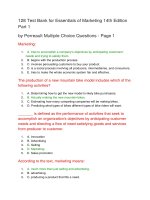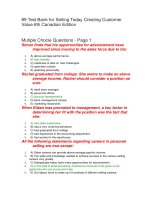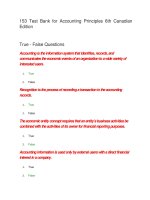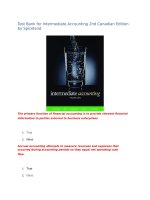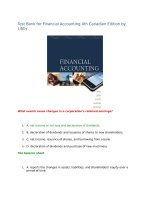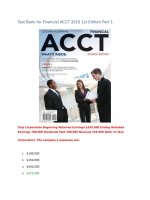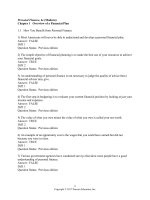test bank solutions personal finance 6th canadian edition kapoor (1)
Bạn đang xem bản rút gọn của tài liệu. Xem và tải ngay bản đầy đủ của tài liệu tại đây (295.17 KB, 31 trang )
Test Bank Solutions Personal Finance 6th Canadian Edition Kapoor Dlabay Hughes
Ahmad Fortino
Chapter 04 Test Bank (key from page 14)
Student:
1. The convenience of using a financial institution with 24-hour banking frequently requires a trade-off
with
A.
B.
C.
D.
E.
safety.
personal service.
growth of savings.
liquidity.
a lower rate of return.
2. A trust has the purpose of
A.
B.
C.
D.
E.
solving a person's financial problems.
obtaining low-interest loans.
handling daily money management activities.
managing the assets of a person.
improving a person's budgeting skills.
3. The storage of funds for future use is the purpose of
A.
B.
C.
D.
E.
trust
borrowing
credit card
savings
cash chequing
4. When interest rates are rising, a person would be best served by
A.
B.
C.
D.
E.
short term loans
long-term savings instruments.
short-term savings instruments.
variable-rate loans.
short-term loans and long-term savings instruments.
services.
5. An all-purpose account that provides several services is a(n):
A.
B.
C.
D.
E.
NOW account.
asset management account.
EFT account.
mutual fund.
money market account.
6. Time deposits consist of
A.
B.
C.
D.
E.
savings accounts.
loans and charge accounts.
chequing accounts.
government securities.
profits earned by a financial institution.
7. Direct deposit and automatic monthly payments are features of
A.
B.
C.
D.
E.
savings accounts.
chequing accounts.
electronic banking.
investments.
reserve funds.
8. To avoid high fees for loans, a person should not borrow from a
A.
B.
C.
D.
E.
credit union.
savings and loan association.
pawnshop.
commercial bank.
mutual savings bank.
9. In recent years, membership in credit unions has
A.
B.
C.
D.
E.
become more difficult due to higher taxes.
continued to increase.
been limited to government employees.
declined due to poor credit union management.
stayed at about the same level.
10. An advantage credit unions may have over other financial institutions is
A.
B.
C.
D.
E.
interest-bearing chequing accounts.
flexible-rate loans
low-cost personal loans.
credit cards.
variable-rate savings plans.
11. The major service offered by investment companies is
A.
B.
C.
D.
E.
interest-bearing checking accounts.
variable-rate loans.
credit card accounts.
savings bonds.
mutual funds.
12. A financial institution organized for the main purpose of providing loans to purchase homes is a
A.
B.
C.
D.
E.
mortgage and loan company.
mutual savings bank.
consumer finance company.
credit union
commercial bank.
13. The business hours and location of a financial institution refer to the
selecting a financial institution.
A.
B.
C.
D.
E.
factor of
safety
cost
compounding
liquidity
convenience
14. Which of the following savings plans is not covered by federal deposit insurance?
A.
B.
C.
D.
E.
a passbook account
a regular chequing account
a money market account
a money market fund
a GIC
15. The rate of return on a savings account is also referred to as
A.
B.
C.
D.
E.
liquidity.
compounding.
asset management.
insolvency.
yield.
16. An advantage of Canada Savings Bonds is
A.
B.
C.
D.
E.
interest earned is exempt from federal income taxes.
interest earned is deferred for federal tax purposes.
a guaranteed rate of return.
they can be converted to other types of investments.
they are sold twice a year.
17. Joan Zemke expects interest rates to decline over the next few months. To maximize her earnings she
should use a(n)
A.
B.
C.
D.
E.
five-year GIC.
interest-bearing chequing account.
regular savings account.
six-month GIC.
money market fund
18. Which of these is not a characteristic of the compound interest bond?
A.
B.
C.
D.
E.
various purchase options
denominations of $100 up to $10,000
interest paid on November 1 of each year
can be purchased by cash
cashable at any time for their face value
19. A saver will usually earn the highest rate with which of the following types of savings plans?
A.
B.
C.
D.
E.
Guaranteed Investment Certificates
club account
passbook account
share account
NOW account
20. A $400 savings account that earns $15 interest in a year has a yield of
A.
B.
C.
D.
E.
6
15
4.75
3.75
6.5
21. Savings compounded
A.
B.
C.
D.
E.
percent.
would have the highest effective yield
monthly
annually
semi-annually
daily
weekly
22. Comparison of earnings for different savings plans can best be accomplished using the
A.
B.
C.
D.
E.
discounted present value.
compounded rate of return.
net present value.
effective annual rate.
after-tax rate of return.
23. If the annual rate is 10%, and the interest is compounded quarterly, what is the effective annual rate?
A.
B.
C.
D.
E.
10.00%
10.25%
10.38%
12.00%
12.68%
24. If the annual rate is 10% and inflation is 4%, then the approximate real rate of return is:
A.
B.
C.
D.
E.
14.00%
4.00%
6.00%
6.80%
7.00%
25. Briana Legett expects interest rates to decline over the next few months. To maximize her earnings
she should use a(n):
A.
B.
C.
D.
E.
regular savings account.
interest-bearing checking account.
five-year certificate of deposit.
six-month certificate of deposit.
money market fund
26. A service designed for people who write only a few cheques each month is a(n)
account.
A.
B.
C.
D.
E.
EFT
regular chequing
share draft
interest-bearing chequing
activity
27. Kevin Friedman only needs to write a couple of cheques each month. Which type of chequing
account would best serve his needs?
A.
B.
C.
D.
E.
an interest-earning chequing account
an activity account
an EFT account
a share draft account
a NOW account
28. The funds deposited in a chequing account can be restricted for use by
A.
B.
C.
D.
E.
a holding period.
outstanding cheques.
interest earned.
service charges.
electronic banking.
29. A personal cheque with guaranteed payment is called a
A.
B.
C.
D.
E.
traveler's cheque.
bank draft.
certified cheque.
money order.
cashier's cheque.
30. The purpose of a "special" endorsement is to
A.
B.
C.
D.
E.
cash a cheque.
deposit a cheque.
transfer a cheque to another person.
withdraw cash from your account.
reduce the charge for service fees.
31. A
cash.
A.
B.
C.
D.
E.
endorsement would be used if a person is presenting a cheque in order to obtain
restrictive
common
special
blank
documented
32. The first information to be recorded when writing a cheque is the
A.
B.
C.
D.
E.
date.
cheque stub or cheque register.
payee.
amount.
signature.
33. When preparing a bank reconciliation, outstanding cheques should be
A.
B.
C.
D.
E.
added to the bank statement balance.
subtracted from the bank statement balance.
added to the chequebook balance.
subtracted from the chequebook balance.
added to direct deposits.
34. In the bank reconciliation process, service fees should be
A.
B.
C.
D.
E.
added to the bank statement balance.
subtracted from the bank statement balance.
added to the chequebook balance.
subtracted from the chequebook balance.
added to direct deposits.
35. Based on the following information, what amount would be SUBTRACTED from the BANK
BALANCE side of a chequing account reconciliation? Service charge $6, Outstanding cheques $260,
Interest $3. 00, Deposit in transit $65
A.
B.
C.
D.
E.
$260
$65
$71
$68
$266
36. The "prime" rate is
A.
B.
C.
D.
E.
.
The lending rate banks charge their most creditworthy clients
The yield on 91-day treasury bills
The yield on 30-year government bonds
The yield on 1-year government bonds
The yield on corporate bonds
37. Which best describes the prime rate of interest?
A.
B.
C.
D.
E.
The lending rate banks charge their most creditworthy clients
The yield on 91-day treasury bills
The yield on 30-year government bonds
The lending rate the Bank of Canada charges financial institutions.
The base rate for all mortgages
38. When interest rates are falling, a person would be best served by
A.
B.
C.
D.
E.
short term loans
short-term savings instruments.
same approach as if interest rates are rising.
variable-rate loans.
long term loans.
39. The yield on a savings account is also referred to as
A.
B.
C.
D.
E.
liquidity.
compounding.
asset management.
insolvency.
rate of return.
40. Which of these is not a characteristic of the compound interest bond?
A.
B.
C.
D.
E.
various purchase options
denominations of $100 up to $10,000
cashable at any time for their face value
can be purchased by cash
A, B, C and D are all characteristics of the compound interest bond.
41. A $100 savings account that earns $5 interest in a year has a yield of
A.
B.
C.
D.
E.
6
5
4.75
3.75
6.5
percent.
42. Savings compounded
A.
B.
C.
D.
E.
would have the lowest effective yield
monthly
annually
semi-annually
daily
weekly
43. If the annual rate is 8%, and the interest is compounded quarterly, what is the effective annual rate?
A.
B.
C.
D.
E.
8.00%
10.25%
10.38%
7.85%
8.24%
44. If the annual rate is 8%, and the interest is compounded monthly, what is the effective annual rate?
A.
B.
C.
D.
E.
8.00%
10.25%
10.38%
7.85%
8.30%
45. If the annual rate is 8%, and the interest is compounded annually, what is the effective annual rate?
A.
B.
C.
D.
E.
8.00%
10.25%
10.38%
7.85%
8.24%
46. If the annual rate is 3% and inflation is 2%, then the approximate real rate of return is:
A.
B.
C.
D.
E.
5.00%
3.00%
1.00%
- 1.0%
0%
47. If the annual rate is 2% and inflation is 3%, then the approximate real rate of return is:
A.
B.
C.
D.
E.
5.00%
3.00%
1.00%
- 1.0%
0%
48. Robert expects interest rates to rise over the next few months. To maximize his earnings he should
use a:
A.
B.
C.
D.
E.
regular savings account.
five year GIC.
five-year certificate of deposit.
six-month certificate of deposit.
money market fund
49. The use of electronic banking does not add to the "float" time for financial services customers.
True
False
50. Time deposits are more commonly referred to deposits made to savings accounts and investment
certificates.
True
False
51. ATM fees are about the same in different geographic areas.
True
False
52. Lower returns on savings will usually result in less liquidity.
True
False
53. A "free" chequing account with a minimum balance of $500 has an opportunity cost of lost interest.
True
False
54. Store credit cards usually charge a higher interest rate than a bank credit card.
True
False
55. Credit unions frequently offer lower loan rates than other financial institutions.
True
False
56. The money market fund offered by investment companies is a highly liquid financial service.
True
False
57. Mortgage and loan companies specialize principally in home mortgages and long-term loans.
True
False
58. A regular savings account usually offers a higher rate of return to savers than other savings plans.
True
False
59. A trust is a safe place for people to make large deposits for maximum security
True
False
60. If you think interest rates will increase, you should consider investing your money in a longer-term
GIC. True
False
61. The more frequent the compounding, the less a person will earn on a savings account.
True
False
62. All financial institutions are able to process customer deposit and withdrawal transactions.
True
False
63. Savers should always attempt to obtain an interest rate that is less than the inflation rate.
True
False
64. The increase in purchasing power of an investment is not reflected in its real rate of return.
True
False
65. Activity accounts are designed for people who write many cheques each month.
True
False
66. A restrictive endorsement will usually include the words "for deposit only."
True
False
67. When preparing a bank reconciliation, interest earned on your chequing account is subtracted from
the bank statement balance.
True
False
68. ATM fees may be different in different geographic areas.
True
False
69. A "free" chequing account with a minimum balance of $500 has no opportunity cost.
True
False
70. Store credit cards usually charge a lower interest rate than a bank credit card.
True
False
71. A regular savings account usually offers a lower rate of return to savers than other savings plans.
True
False
72. If you think interest rates will decrease, you should consider investing your money in a longer-term
GIC.
True
False
73. What are the main types of financial institutions used by consumers?
74. Evan Kostakis is living in this country while going to school. He is not familiar with the operation of
savings plans available to consumers. What factors would you recommend that he consider when
evaluating and comparing different savings plans?
75. Brad Kellogg maintains a monthly balance in his chequing account of approximately $150, writes
about 25 cheques a month, and makes three deposits each month. How would Brad decide which of
the following chequing accounts to use?
I. a regular chequing account with a monthly fee of $4.50 for an unlimited number of cheques and no
monthly balance required; no interest earned
II. an interest-bearing chequing account paying 4 percent interest on balances over $300; monthly
service charge of $6 when the balance is below $300
III. a special chequing account that charges 35 cents a cheque and 20 cents for each deposit; no
interest earned
IV. a minimum-balance account that requires a $200 minimum balance to avoid the $10 monthly fee;
interest earned when balance is above $400.
76. Based on the following information, find the true balance of your chequing account and the sum, if
any, of deposits in transit.
Balance on bank statement, $581
Total of outstanding cheques, $200
Service charges, $11
Interest earned on account, $7
Balance in your chequebook, $540
77. List the fees and charges that chequing accounts may have.
78. List the 4 chequing account selection features discussed in the text.
04 KEY
1. (p. 120) The convenience of using a financial institution with 24-hour banking frequently requires a
trade-off with
A.
B.
C.
D.
E.
safety.
personal service.
growth of savings.
liquidity.
a lower rate of return.
Difficulty: Hard
Gradable: automatic
Kapoor - Chapter 04 #1
Learning Objective: 1
2. (p. 118) A trust has the purpose of
A.
B.
C.
D.
E.
solving a person's financial problems.
obtaining low-interest loans.
handling daily money management activities.
managing the assets of a person.
improving a person's budgeting skills.
Difficulty: Medium
Gradable: automatic
Kapoor - Chapter 04 #2
Learning Objective: 1
3. (p. 118) The storage of funds for future use is the purpose of
A.
B.
C.
D.
E.
services.
trust
borrowing
credit card
savings
cash chequing
Difficulty: Easy
Gradable: automatic
Kapoor - Chapter 04 #3
Learning Objective: 1
4. (p. 121) When interest rates are rising, a person would be best served by
A.
B.
C.
D.
E.
short term loans
long-term savings instruments.
short-term savings instruments.
variable-rate loans.
short-term loans and long-term savings instruments.
Difficulty: Hard
Gradable: automatic
Kapoor - Chapter 04 #4
Learning Objective: 1
5. (p. 118) An all-purpose account that provides several services is a(n):
A.
B.
C.
D.
E.
NOW account.
asset management account.
EFT account.
mutual fund.
money market account.
Difficulty: Medium
Gradable: automatic
Kapoor - Chapter 04 #5
Learning Objective: 1
6. (p. 118) Time deposits consist of
A.
B.
C.
D.
E.
savings accounts.
loans and charge accounts.
chequing accounts.
government securities.
profits earned by a financial institution.
Difficulty: Medium
Gradable: automatic
Kapoor - Chapter 04 #6
Learning Objective: 1
7. (p. 119) Direct deposit and automatic monthly payments are features of
A.
B.
C.
D.
E.
savings accounts.
chequing accounts.
electronic banking.
investments.
reserve funds.
Difficulty: Easy
Gradable: automatic
Kapoor - Chapter 04 #7
Learning Objective: 1
8. (p. 124) To avoid high fees for loans, a person should not borrow from a
A.
B.
C.
D.
E.
credit union.
savings and loan association.
pawnshop.
commercial bank.
mutual savings bank.
Difficulty: Easy
Gradable: automatic
Kapoor - Chapter 04 #8
Learning Objective: 2
9. (p. 123) In recent years, membership in credit unions has
A.
B.
C.
D.
E.
become more difficult due to higher taxes.
continued to increase.
been limited to government employees.
declined due to poor credit union management.
stayed at about the same level.
Difficulty: Easy
Gradable: automatic
Kapoor - Chapter 04 #9
Learning Objective: 2
10. (p. 123) An advantage credit unions may have over other financial institutions is
A.
B.
C.
D.
E.
interest-bearing chequing accounts.
flexible-rate loans
low-cost personal loans.
credit cards.
variable-rate savings plans.
Difficulty: Medium
Gradable: automatic
Kapoor - Chapter 04 #10
Learning Objective: 2
11. (p. 123) The major service offered by investment companies is
A.
B.
C.
D.
E.
interest-bearing checking accounts.
variable-rate loans.
credit card accounts.
savings bonds.
mutual funds.
Difficulty: Medium
Gradable: automatic
Kapoor - Chapter 04 #11
Learning Objective: 2
12. (p. 124) A financial institution organized for the main purpose of providing loans to purchase homes is
a
A.
B.
C.
D.
E.
mortgage and loan company.
mutual savings bank.
consumer finance company.
credit union
commercial bank.
Difficulty: Easy
Gradable: automatic
Kapoor - Chapter 04 #12
Learning Objective: 2
13. (p. 125) The business hours and location of a financial institution refer to the
selecting a financial institution.
A.
B.
C.
D.
E.
factor of
safety
cost
compounding
liquidity
convenience
Difficulty: Easy
Gradable: automatic
Kapoor - Chapter 04 #13
Learning Objective: 2
14. (p. 124) Which of the following savings plans is not covered by federal deposit insurance?
A.
B.
C.
D.
E.
a passbook account
a regular chequing account
a money market account
a money market fund
a GIC
Difficulty: Medium
Gradable: automatic
Kapoor - Chapter 04 #14
Learning Objective: 2
15. (p. 129) The rate of return on a savings account is also referred to as
A.
B.
C.
D.
E.
liquidity.
compounding.
asset management.
insolvency.
yield.
Difficulty: Medium
Gradable: automatic
Kapoor - Chapter 04 #15
Learning Objective: 3
16. (p. 128) An advantage of Canada Savings Bonds is
A.
B.
C.
D.
E.
interest earned is exempt from federal income taxes.
interest earned is deferred for federal tax purposes.
a guaranteed rate of return.
they can be converted to other types of investments.
they are sold twice a year.
Difficulty: Medium
Gradable: automatic
Kapoor - Chapter 04 #16
Learning Objective: 3
17. (p. 128) Joan Zemke expects interest rates to decline over the next few months. To maximize her
earnings she should use a(n)
A.
B.
C.
D.
E.
five-year GIC.
interest-bearing chequing account.
regular savings account.
six-month GIC.
money market fund
Difficulty: Hard
Gradable: automatic
Kapoor - Chapter 04 #17
Learning Objective: 3
18. (p. 128- Which of these is not a characteristic of the compound interest bond?
129)
A.
B.
C.
D.
E.
various purchase options
denominations of $100 up to $10,000
interest paid on November 1 of each year
can be purchased by cash
cashable at any time for their face value
Difficulty: Hard
Gradable: automatic
Kapoor - Chapter 04 #18
Learning Objective: 3
19. (p. 128) A saver will usually earn the highest rate with which of the following types of savings plans?
A.
B.
C.
D.
E.
Guaranteed Investment Certificates
club account
passbook account
share account
NOW account
Difficulty: Easy
Gradable: automatic
Kapoor - Chapter 04 #19
Learning Objective: 3
20. (p. 129) A $400 savings account that earns $15 interest in a year has a yield of
A.
B.
C.
D.
E.
percent.
6
15
4.75
3.75
6.5
Difficulty: Medium
Gradable: automatic
Kapoor - Chapter 04 #20
Learning Objective: 3
21. (p. 129) Savings compounded
A.
B.
C.
D.
E.
would have the highest effective yield
monthly
annually
semi-annually
daily
weekly
Difficulty: Easy
Gradable: automatic
Kapoor - Chapter 04 #21
Learning Objective: 3
22. (p. 130) Comparison of earnings for different savings plans can best be accomplished using the
A.
B.
C.
D.
E.
discounted present value.
compounded rate of return.
net present value.
effective annual rate.
after-tax rate of return.
Difficulty: Medium
Gradable: automatic
Kapoor - Chapter 04 #22
Learning Objective: 4
23. (p. 130) If the annual rate is 10%, and the interest is compounded quarterly, what is the effective annual
rate?
A.
B.
C.
D.
E.
10.00%
10.25%
10.38%
12.00%
12.68%
Difficulty: Hard
Gradable: automatic
Kapoor - Chapter 04 #23
Learning Objective: 4
24. (p. 130) If the annual rate is 10% and inflation is 4%, then the approximate real rate of return is:
A.
B.
C.
D.
E.
14.00%
4.00%
6.00%
6.80%
7.00%
Difficulty: Medium
Gradable: automatic
Kapoor - Chapter 04 #24
Learning Objective: 4
25. (p. 132) Briana Legett expects interest rates to decline over the next few months. To maximize her
earnings she should use a(n):
A.
B.
C.
D.
E.
regular savings account.
interest-bearing checking account.
five-year certificate of deposit.
six-month certificate of deposit.
money market fund
Difficulty: Hard
Gradable: automatic
Kapoor - Chapter 04 #25
Learning Objective: 4
26. (p. 132) A service designed for people who write only a few cheques each month is a(n)
account.
A.
B.
C.
D.
E.
EFT
regular chequing
share draft
interest-bearing chequing
activity
Difficulty: Medium
Gradable: automatic
Kapoor - Chapter 04 #26
Learning Objective: 5
27. (p. 132) Kevin Friedman only needs to write a couple of cheques each month. Which type of chequing
account would best serve his needs?
A.
B.
C.
D.
E.
an interest-earning chequing account
an activity account
an EFT account
a share draft account
a NOW account
Difficulty: Medium
Gradable: automatic
Kapoor - Chapter 04 #27
Learning Objective: 5
28. (p. 133) The funds deposited in a chequing account can be restricted for use by
A.
B.
C.
D.
E.
a holding period.
outstanding cheques.
interest earned.
service charges.
electronic banking.
Difficulty: Medium
Gradable: automatic
Kapoor - Chapter 04 #28
Learning Objective: 5
29. (p. 133) A personal cheque with guaranteed payment is called a
A.
B.
C.
D.
E.
traveler's cheque.
bank draft.
certified cheque.
money order.
cashier's cheque.
Difficulty: Medium
Gradable: automatic
Kapoor - Chapter 04 #29
Learning Objective: 5
30. (p. 140) The purpose of a "special" endorsement is to
A.
B.
C.
D.
E.
cash a cheque.
deposit a cheque.
transfer a cheque to another person.
withdraw cash from your account.
reduce the charge for service fees.
Difficulty: Medium
Gradable: automatic
Kapoor - Chapter 04 #30
Learning Objective: 5
31. (p. 140) A
obtain cash.
A.
B.
C.
D.
E.
endorsement would be used if a person is presenting a cheque in order to
restrictive
common
special
blank
documented
Difficulty: Medium
Gradable: automatic
Kapoor - Chapter 04 #31
Learning Objective: 5
32. (p. 141) The first information to be recorded when writing a cheque is the
A.
B.
C.
D.
E.
date.
cheque stub or cheque register.
payee.
amount.
signature.
Difficulty: Easy
Gradable: automatic
Kapoor - Chapter 04 #32
Learning Objective: 5
33. (p. 142) When preparing a bank reconciliation, outstanding cheques should be
A.
B.
C.
D.
E.
added to the bank statement balance.
subtracted from the bank statement balance.
added to the chequebook balance.
subtracted from the chequebook balance.
added to direct deposits.
Difficulty: Medium
Gradable: automatic
Kapoor - Chapter 04 #33
Learning Objective: 5
34. (p. 142) In the bank reconciliation process, service fees should be
A.
B.
C.
D.
E.
added to the bank statement balance.
subtracted from the bank statement balance.
added to the chequebook balance.
subtracted from the chequebook balance.
added to direct deposits.
Difficulty: Medium
Gradable: automatic
Kapoor - Chapter 04 #34
Learning Objective: 5
35. (p. 142) Based on the following information, what amount would be SUBTRACTED from the BANK
BALANCE side of a chequing account reconciliation? Service charge $6, Outstanding cheques
$260, Interest $3. 00, Deposit in transit $65
A.
B.
C.
D.
E.
$260
$65
$71
$68
$266
Difficulty: Medium
Gradable: automatic
Kapoor - Chapter 04 #35
Learning Objective: 3
36. (p. 122) The "prime" rate is
A.
B.
C.
D.
E.
.
The lending rate banks charge their most creditworthy clients
The yield on 91-day treasury bills
The yield on 30-year government bonds
The yield on 1-year government bonds
The yield on corporate bonds
Difficulty: Easy
Gradable: automatic
Kapoor - Chapter 04 #36
Learning Objective: 2
37. (p. 122) Which best describes the prime rate of interest?
A.
B.
C.
D.
E.
The lending rate banks charge their most creditworthy clients
The yield on 91-day treasury bills
The yield on 30-year government bonds
The lending rate the Bank of Canada charges financial institutions.
The base rate for all mortgages
Difficulty: Easy
Gradable: automatic
Kapoor - Chapter 04 #37
Learning Objective: 1
38. (p. 121) When interest rates are falling, a person would be best served by
A.
B.
C.
D.
E.
short term loans
short-term savings instruments.
same approach as if interest rates are rising.
variable-rate loans.
long term loans.
Difficulty: Hard
Gradable: automatic
Kapoor - Chapter 04 #38
Learning Objective: 1
39. (p. 129) The yield on a savings account is also referred to as
A.
B.
C.
D.
E.
liquidity.
compounding.
asset management.
insolvency.
rate of return.
Difficulty: Medium
Gradable: automatic
Kapoor - Chapter 04 #39
Learning Objective: 3
40. (p. 128- Which of these is not a characteristic of the compound interest bond?
129)
A.
B.
C.
D.
E.
various purchase options
denominations of $100 up to $10,000
cashable at any time for their face value
can be purchased by cash
A, B, C and D are all characteristics of the compound interest bond.
Difficulty: Hard
Gradable: automatic
Kapoor - Chapter 04 #40
Learning Objective: 3
41. (p. 129) A $100 savings account that earns $5 interest in a year has a yield of
A.
B.
C.
D.
E.
percent.
6
5
4.75
3.75
6.5
Difficulty: Easy
Gradable: automatic
Kapoor - Chapter 04 #41
Learning Objective: 3
42. (p. 129) Savings compounded
A.
B.
C.
D.
E.
would have the lowest effective yield
monthly
annually
semi-annually
daily
weekly
Difficulty: Easy
Gradable: automatic
Kapoor - Chapter 04 #42
Learning Objective: 3
43. (p. 130) If the annual rate is 8%, and the interest is compounded quarterly, what is the effective annual
rate?
A.
B.
C.
D.
E.
8.00%
10.25%
10.38%
7.85%
8.24%
Difficulty: Hard
Gradable: automatic
Kapoor - Chapter 04 #43
Learning Objective: 4
44. (p. 130) If the annual rate is 8%, and the interest is compounded monthly, what is the effective annual
rate?
A.
B.
C.
D.
E.
8.00%
10.25%
10.38%
7.85%
8.30%
Difficulty: Hard
Gradable: automatic
Kapoor - Chapter 04 #44
Learning Objective: 4
45. (p. 130) If the annual rate is 8%, and the interest is compounded annually, what is the effective annual
rate?
A.
B.
C.
D.
E.
8.00%
10.25%
10.38%
7.85%
8.24%
Difficulty: Medium
Gradable: automatic
Kapoor - Chapter 04 #45
Learning Objective: 4
46. (p. 130) If the annual rate is 3% and inflation is 2%, then the approximate real rate of return is:
A.
B.
C.
D.
E.
5.00%
3.00%
1.00%
- 1.0%
0%
Difficulty: Medium
Gradable: automatic
Kapoor - Chapter 04 #46
Learning Objective: 4
47. (p. 130) If the annual rate is 2% and inflation is 3%, then the approximate real rate of return is:
A.
B.
C.
D.
E.
5.00%
3.00%
1.00%
- 1.0%
0%
Difficulty: Medium
Gradable: automatic
Kapoor - Chapter 04 #47
Learning Objective: 4
48. (p. 132) Robert expects interest rates to rise over the next few months. To maximize his earnings he
should use a:
A.
B.
C.
D.
E.
regular savings account.
five year GIC.
five-year certificate of deposit.
six-month certificate of deposit.
money market fund
Difficulty: Hard
Gradable: automatic
Kapoor - Chapter 04 #48
Learning Objective: 4
